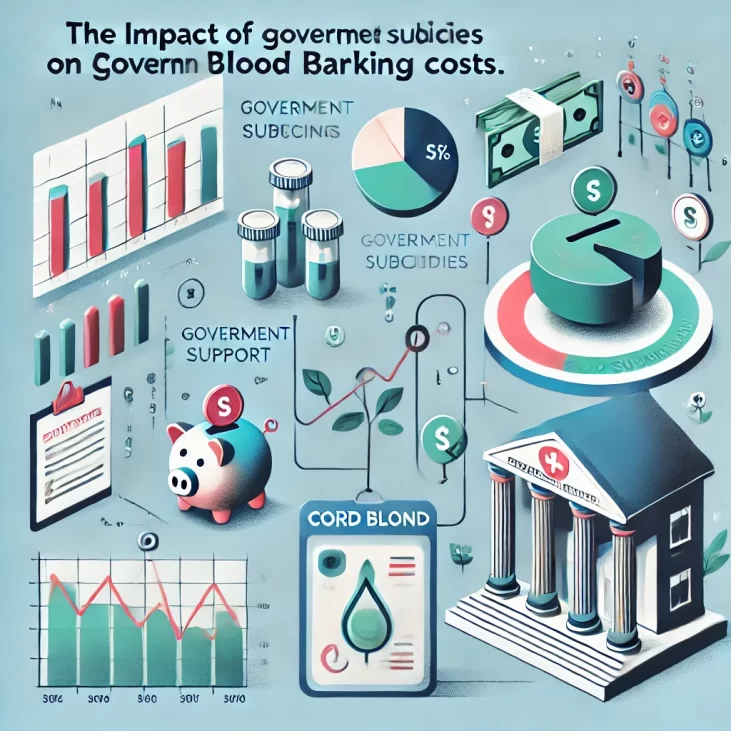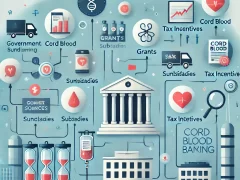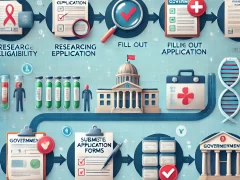
The Role of Government Subsidies in Cord Blood Banking Costs
The Influence of Government Subsidies on Cord Blood Banking Costs
Cord blood banking has become an increasingly important aspect of modern healthcare, offering families the opportunity to preserve potentially life-saving stem cells for future use. However, the cost of cord blood banking can be a significant barrier for many individuals and families. This is where government subsidies can play a crucial role in making this valuable service more accessible.
The High Cost of Cord Blood Banking
Cord blood banking typically involves an initial collection fee, followed by an annual storage fee. These costs can add up quickly, often reaching thousands of dollars over the course of the storage period. For many families, particularly those with limited financial resources, the expense of cord blood banking can be prohibitive, preventing them from accessing this potentially life-saving technology.
The Role of Government Subsidies
Government subsidies can play a vital role in addressing the cost barriers associated with cord blood banking. By providing financial assistance, either through direct subsidies or tax incentives, governments can help to make cord blood banking more affordable and accessible to a broader segment of the population.
Improving Accessibility and Diversity
One of the key benefits of government subsidies for cord blood banking is the potential to improve accessibility and diversity within cord blood banks. By reducing the financial burden for families, subsidies can encourage more individuals to participate in cord blood banking, leading to a more diverse and representative pool of stored samples. This, in turn, can increase the likelihood of finding compatible matches for those in need of stem cell transplants, ultimately improving patient outcomes.
Promoting Public-Private Partnerships
In addition to direct subsidies, governments can also play a role in promoting public-private partnerships within the cord blood banking industry. By collaborating with private cord blood banks, governments can help to drive down costs, improve efficiency, and ensure that cord blood banking services are more widely available to the public.
Ensuring Ethical Practices and Oversight
When implementing government subsidies for cord blood banking, it is crucial that policymakers ensure robust ethical practices and oversight. This may involve establishing regulations around informed consent, protecting donor privacy, and ensuring that subsidies are allocated in a fair and equitable manner, without discrimination or exploitation.
The Impact on Cord Blood Bank Sustainability
While government subsidies can play a valuable role in improving accessibility, it is also important to consider the potential impact on the long-term sustainability of cord blood banks. Policymakers must carefully balance the need for affordability with the need to maintain a robust and viable cord blood banking infrastructure that can continue to serve the needs of the population.
The role of government subsidies in cord blood banking costs is a complex and multifaceted issue. By addressing the financial barriers to cord blood banking, subsidies can help to improve accessibility and diversity within the system, ultimately benefiting patients in need of stem cell transplants. However, it is essential that these subsidies are implemented in a way that promotes ethical practices, ensures oversight, and maintains the long-term sustainability of the cord blood banking industry.
Evaluating the Financial Impact of Subsidies on Cord Blood Preservation
The Influence of Government Subsidies on Cord Blood Banking Costs
Cord blood banking has emerged as a valuable healthcare service, providing families with the option to store their newborn’s stem cells for potential future medical use. However, the costs associated with cord blood preservation can be a significant financial burden for many families. In this context, government subsidies have become an essential factor in shaping the accessibility and affordability of this service.
Evaluating the Cost Factors in Cord Blood Banking
The expenses involved in cord blood banking can be categorized into several components. The initial collection and processing fees, which cover the medical staff, equipment, and laboratory procedures, constitute a substantial portion of the overall costs. Additionally, families often face annual storage fees to maintain the preserved cord blood sample. These ongoing costs can accumulate over the years, making it challenging for some families to afford the long-term commitment.
The Role of Government Subsidies in Reducing Cord Blood Banking Costs
Government subsidies have the potential to alleviate the financial burden associated with cord blood banking. By providing direct financial assistance or tax incentives, governments can help offset the initial collection and processing fees, as well as the recurring storage costs. This support can make cord blood banking more accessible to a broader range of families, regardless of their socioeconomic status.
Variations in Subsidy Policies Across Jurisdictions
The approach to government subsidies for cord blood banking can vary significantly across different jurisdictions. Some countries have established comprehensive nationwide programs that offer substantial financial assistance, while others have limited or sporadic subsidy initiatives. These disparities in subsidy policies can lead to disparities in access to cord blood banking services, potentially creating geographic and socioeconomic divides in healthcare opportunities.
Evaluating the Effectiveness of Subsidy Programs
Assessing the effectiveness of government subsidy programs for cord blood banking is crucial to ensure that the intended benefits are being realized. Factors such as the level of financial support, the accessibility and awareness of the subsidy program, and the overall impact on cord blood banking utilization rates should be closely monitored and evaluated. Periodic reviews and adjustments to subsidy policies can help optimize the program’s effectiveness and ensure that it aligns with the evolving needs of families and the healthcare system.
Balancing Subsidies with Sustainable Cord Blood Banking
While government subsidies can significantly improve the affordability of cord blood banking, it is essential to strike a balance between the level of subsidies and the long-term sustainability of the cord blood banking industry. Excessive dependence on subsidies may lead to market distortions or financial instability in the sector. Policymakers should consider strategies that foster a healthy, self-sustaining cord blood banking ecosystem, where subsidies complement other initiatives, such as technological advancements, streamlined operations, and innovative funding models.
The impact of government subsidies on cord blood banking costs is a multifaceted issue that requires a comprehensive understanding of the various cost factors, subsidy policies, and the overall healthcare landscape. By carefully evaluating and optimizing the subsidy programs, policymakers can help ensure that families have equitable access to this valuable healthcare service, ultimately improving the well-being of individuals and communities.
Balancing Affordability and Access in Cord Blood Banking
Unlocking the Potential of Cord Blood Banking
The world of healthcare has seen a remarkable advancement in the field of cord blood banking, a revolutionary technology that holds the promise of transforming lives. However, the accessibility and affordability of this service have become a pressing concern, as the costs associated with cord blood banking can be a significant barrier for many families. In this article, we will explore the impact of government subsidies on cord blood banking costs and the delicate balance between ensuring affordability and maintaining access to this invaluable medical resource.
The Significance of Cord Blood Banking
Cord blood banking is a process in which the blood from a newborn’s umbilical cord is collected, processed, and stored for potential future use. This precious resource is rich in stem cells, which have the remarkable ability to develop into various cell types, making them a valuable tool in the treatment of a wide range of medical conditions, from blood disorders to regenerative therapies.
The Cost Conundrum in Cord Blood Banking
The process of cord blood banking can be a significant financial burden for families. The initial collection, processing, and storage fees can range from hundreds to thousands of dollars, depending on the service provider and the specific package chosen. This high cost can exclude many families from accessing this potentially life-saving technology, creating a disparity in healthcare access.
The Role of Government Subsidies
To address this issue, governments around the world have taken steps to make cord blood banking more accessible and affordable. By offering subsidies or financial assistance programs, these initiatives aim to alleviate the financial burden on families and increase the overall utilization of cord blood banking services.
Balancing Affordability and Access
The implementation of government subsidies for cord blood banking presents a delicate balance between ensuring affordability and maintaining access to this critical medical resource. On one hand, the subsidies can make cord blood banking more accessible to a broader population, enabling more families to benefit from this technology. However, there are concerns that the increased demand driven by the subsidies may lead to supply shortages or longer waiting times, potentially compromising the availability of cord blood units for those in immediate need.
Optimizing Cord Blood Banking Subsidies
To strike the right balance, policymakers and healthcare providers must carefully consider the factors that influence the cost and accessibility of cord blood banking. This may involve:
- Identifying the populations most in need of financial assistance and targeting the subsidies accordingly.
- Encouraging collaboration between private cord blood banks and public healthcare systems to create sustainable and equitable models of service delivery.
- Investing in research and development to improve the efficiency and cost-effectiveness of cord blood banking processes.
- Establishing clear guidelines and regulations to ensure the quality and safety of the stored cord blood units.
Empowering Families through Informed Decisions
Additionally, it is crucial to empower families with comprehensive information about the benefits, risks, and financial implications of cord blood banking. By providing transparent and accessible resources, families can make informed decisions that align with their individual needs and financial capabilities, further enhancing the overall accessibility and utilization of this valuable medical service.
The impact of government subsidies on cord blood banking costs is a complex and multifaceted issue that requires a delicate balance between affordability and access. By implementing strategic policies, fostering collaborations, and empowering families with knowledge, we can unlock the true potential of cord blood banking and ensure that this life-saving technology is available to all who need it, regardless of their financial circumstances. As we continue to navigate this evolving landscape, the commitment to making cord blood banking accessible and affordable will be a crucial step in shaping a healthier and more equitable future for generations to come.
Addressing Equity Concerns in Cord Blood Banking Through Subsidies
Examining the Role of Government Subsidies in Enhancing Cord Blood Banking Accessibility
Cord blood banking has emerged as a critical component of modern healthcare, offering potential treatments for a wide range of ailments. However, the significant costs associated with cord blood banking have raised concerns about equity and accessibility, particularly for individuals from low-income backgrounds. In this context, government subsidies have been proposed as a potential solution to address these disparities.
Evaluating the Impact of Subsidies on Cord Blood Banking Costs
The high costs of cord blood banking can be a significant barrier to access, limiting the ability of many families to preserve this valuable resource. Government subsidies can play a crucial role in reducing these financial burdens, making cord blood banking more affordable and accessible to a broader segment of the population. By providing financial assistance, subsidies can help offset the costs of collection, processing, and long-term storage, making it more feasible for families to participate in cord blood banking.
Addressing Socioeconomic Disparities in Cord Blood Banking
Cord blood banking has the potential to provide life-saving treatments, but the high costs can exacerbate existing socioeconomic disparities. Families with higher incomes may have the financial resources to afford the expenses associated with cord blood banking, while those from lower-income backgrounds may be excluded from this potentially life-saving option. Government subsidies can help to bridge this gap, ensuring that individuals from diverse socioeconomic backgrounds have equal access to the benefits of cord blood banking.
Promoting Genetic Diversity in Cord Blood Banks
Cord blood banks rely on a diverse pool of donors to provide effective treatments for a wide range of genetic and ethnic backgrounds. However, the current landscape of cord blood banking has faced challenges in achieving adequate representation from underserved communities. Government subsidies can play a crucial role in addressing this issue by making cord blood banking more accessible to these populations. By incentivizing participation and reducing financial barriers, subsidies can help to increase the diversity of cord blood samples, ultimately improving the chances of finding suitable matches for patients in need.
Balancing Sustainability and Accessibility
While government subsidies can significantly enhance the accessibility of cord blood banking, policymakers must also consider the long-term sustainability of such programs. Ensuring the financial viability of cord blood banking infrastructure is essential to maintain the availability of these services over time. Careful planning and strategic allocation of resources can help to strike a balance between improving accessibility and ensuring the long-term sustainability of the system.
Fostering Collaboration and Public-Private Partnerships
Addressing the challenges of equity in cord blood banking will require a collaborative approach involving various stakeholders. Government entities, healthcare providers, and private cord blood banking organizations can work together to develop comprehensive strategies that leverage the strengths of each sector. By fostering public-private partnerships, stakeholders can identify innovative solutions, pool resources, and create a more inclusive and accessible cord blood banking ecosystem.
Government subsidies have the potential to play a transformative role in enhancing the accessibility and equity of cord blood banking. By reducing financial barriers, promoting genetic diversity, and fostering collaborative efforts, subsidies can help ensure that the benefits of cord blood banking are available to individuals from all socioeconomic backgrounds. As policymakers and stakeholders continue to explore these solutions, the ultimate goal should be to create a more inclusive and equitable healthcare landscape that empowers families to make informed decisions about preserving this invaluable resource.
Exploring Innovative Financing Models for Sustainable Cord Blood Programs
The realm of cord blood banking has long grappled with the challenge of ensuring accessible and affordable services for families. With the potential to revolutionize regenerative medicine, the preservation of this invaluable biological resource has become a crucial consideration for healthcare providers and policymakers alike. In this exploration, we dive into the innovative financing models that are shaping the future of sustainable cord blood programs.
Rethinking the Funding Paradigm
Traditionally, the costs associated with cord blood banking have often been a significant barrier for many families. The high upfront fees and ongoing maintenance expenses have limited the reach of these programs, leaving them inaccessible to those who could benefit the most. However, a paradigm shift is underway, as government subsidies and alternative funding mechanisms are emerging as viable solutions.
The Role of Government Subsidies
Government subsidies have the potential to play a pivotal role in making cord blood banking more accessible and affordable. By providing financial support to cord blood collection and storage facilities, policymakers can help alleviate the financial burden on families, ensuring that this valuable resource is within reach for a broader demographic. These subsidies can take various forms, such as tax incentives, direct funding, or reimbursement programs, all of which can have a significant impact on the overall cost structure.
Innovative Financing Models
Alongside government subsidies, innovative financing models are also shaping the future of sustainable cord blood programs. One such model is the introduction of public-private partnerships, where private sector entities collaborate with government agencies or non-profit organizations to share the financial responsibility. This approach can leverage the strengths and resources of both sectors, creating a more diverse and sustainable funding ecosystem.
Another emerging model is the concept of cord blood banking as a service, where families can access the storage and preservation services through a subscription-based model. This approach can help spread the costs over time, making it more manageable for families and potentially increasing participation in cord blood banking programs.
The Impact on Accessibility and Affordability
The implementation of these innovative financing models can have a profound impact on the accessibility and affordability of cord blood banking services. By reducing the financial barriers, more families can participate in these programs, ensuring that the invaluable biological resources stored in cord blood are available for potential future medical applications.
Moreover, the increased accessibility can also contribute to the growth and sustainability of the cord blood banking industry as a whole. As more families choose to preserve their newborns’ cord blood, the volume of samples available for research and clinical use can expand, fueling advancements in regenerative medicine and ultimately benefiting the broader healthcare ecosystem.
Alongside the financial considerations, the regulatory environment surrounding cord blood banking also plays a crucial role in shaping the sustainability of these programs. Policymakers and industry stakeholders must collaborate to establish clear guidelines, quality standards, and ethical frameworks that ensure the responsible and transparent management of cord blood samples.
By addressing both the financial and regulatory aspects of cord blood banking, the industry can create a more robust and sustainable ecosystem, empowering families to make informed decisions about preserving this valuable biological asset.
The future of sustainable cord blood programs lies in the innovative financing models that are emerging to address the longstanding challenges of accessibility and affordability. Through government subsidies, public-private partnerships, and subscription-based services, the cord blood banking industry can unlock new opportunities for families to participate in these transformative programs.
As we navigate this evolving landscape, it is crucial that stakeholders, including healthcare providers, policymakers, and industry leaders, work together to create a more inclusive and sustainable cord blood banking ecosystem. By doing so, we can ensure that the promise of regenerative medicine becomes a reality for generations to come.
Conclusion
Government subsidies play a critical role in shaping the accessibility and affordability of cord blood banking services. By providing financial support, these subsidies can help offset the substantial costs associated with cord blood preservation, making it more feasible for families from diverse socioeconomic backgrounds to take advantage of this valuable medical resource.
The financial impact of subsidies on cord blood banking has been significant. With the high costs of collection, processing, and long-term storage, many families would be priced out of the market without government intervention. Subsidies help bridge this gap, ensuring that the benefits of cord blood banking are not limited to only the wealthy. By evaluating the true cost-effectiveness of these programs, policymakers can work to strike a balance between providing adequate support and maintaining the financial viability of cord blood banking initiatives.
Ensuring the equitable access to cord blood banking is another crucial consideration when assessing the role of government subsidies. Historically, cord blood banks have faced challenges in serving underrepresented communities, leading to disparities in representation within donor registries. Subsidies can help address these concerns by making cord blood banking more accessible to marginalized populations, fostering greater diversity and inclusion within the system.
As the demand for cord blood-derived therapies continues to grow, innovative financing models will be essential for sustaining the long-term viability of cord blood programs. Governments can play a pivotal role in this regard, exploring alternative funding mechanisms that leverage public-private partnerships, crowdsourcing platforms, and strategic investments. By diversifying the sources of support, these programs can become more resilient and adaptable to evolving healthcare needs.
Government subsidies have a profound impact on the accessibility and affordability of cord blood banking services. By addressing the financial barriers, promoting equity, and exploring innovative financing strategies, these subsidies can help ensure that the life-saving potential of cord blood is realized by individuals and communities across the socioeconomic spectrum. As the field of regenerative medicine continues to evolve, the strategic use of government support will be crucial in unlocking the full benefits of cord blood banking for generations to come.



















